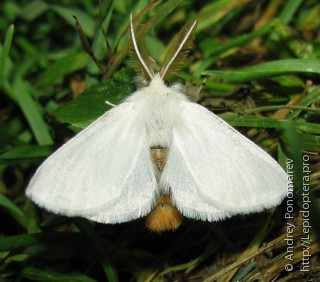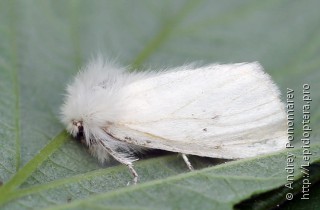Euproctis chrysorrhoea
Taxonomy
class Insecta
Species name(s)
Euproctis (Euproctis) chrysorrhoea (Linnaeus, 1758) = Phalaena chrysorrhoea Linnaeus, 1758 = Phalaena (Bombyx) auriflua Esper, 1785 = Bombyx phaeorrhoeus Haworth, 1803 = Bombyx phaeorrhoea Donovan, 1813 = Nygmia phaeorrhoea = Arctornis chrysorrhoea = Nygmia phaeorrhoea Donovan, 1813. [9, 10, 186]
Brown-tail.
urn:lsid:insecta.pro:taxonomy:6952
Expansion
Zoogeographical regions
Palaearctic, Nearctic.
Russia regions
#1. Kaliningradsky; #4. Evropeisky Severo-Zapadny; #6. Evropeisky Severo-Vostochny; #7. Evropeisky yuzhno-tayozhny; #8. Evropeisky Tsentralny; #9. Evropeisky Tsentralno-Chernozyomny; #10. Sredne-Volzhsky; #11. Volgo-Donsky; #12. Nizhnevolzhsky; #13. Zapadno-Kavkazsky; #14. Vostochno-Kavkazsky; #16. Sredne-Uralsky; #17. Yuzhno-Uralsky.
Forewing length
18—20 mm.
Primary colors
Red, Orange, Brown/Gray/Black, White.
Flight time
| January | February | March | April | May | June | July | August | September | October | November | December |
Larva lifespan
| January | February | March | April | May | June | July | August | September | October | November | December |
Detailed information with references
Distribution
Imago Habitus and Differences from alike species
General info about Imago
Imago lifespan
General info about Larva
Larva food plants / other food objects
Larva lifespan
Egg
Subspecies of Euproctis chrysorrhoea
- Euproctis chrysorrhoea chrysorrhoea. [9]
- E. c. xanthorroea Oberthür, 1916. [187]
Authors
Initial species uploading to the site: Peter Khramov.
Text data: Peter Khramov.
The species characteristics formalization: Peter Khramov.
References
- [1] O. Karsholt, J. Razowski (eds.), 1996. The Lepidoptera of Europe: a distributional checklist
- [3] Каталог чешуекрылых (Lepidoptera) России. Под ред. С. Ю. Синёва. СПб.; М.: Товарищество научных изданий КМК, 2008
- [5] Райххолф-Рим Х. Бабочки. М.: Астрель, 2002
- [9] Tree of Life (funet.fi), 2012
- [10] de Jong, Y.S.D.M. (ed.) (2011) Fauna Europaea version 2.4 (faunaeur.org)
- [28] Moths and Butterflies of Europe and North Africa (leps.it), 2012
- [186] Integrated Taxonomic Information System on-line database, http://www.itis.gov
- [187] Species 2000, http://www.sp2000.org
Comments
Note: you should have a Insecta.pro account to upload new topics and comments. Please, create an account or log in to add comments
Euproctis chrysorrhoea photos








All the photos of the species in large size
Please, create an account or log in to upload your photo









